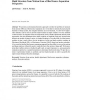Free Online Productivity Tools
i2Speak
i2Symbol
i2OCR
iTex2Img
iWeb2Print
iWeb2Shot
i2Type
iPdf2Split
iPdf2Merge
i2Bopomofo
i2Arabic
i2Style
i2Image
i2PDF
iLatex2Rtf
Sci2ools
IJCV
2010
2010
Rigid Structure from Motion from a Blind Source Separation Perspective
We present an information theoretic approach to de’¼üne the problem of structure from motion (SfM) as a blind source separation one. Given that for almost all practical joint densities of shape points, the marginal densities are non-Gaussian, we show how higherorder statistics can be used to provide improvements in shape estimates over the methods of factorization via Singular Value Decomposition (SVD), bundle adjustment and Bayesian approaches. Previous techniques have either explicitly or implicitly used only second-order statistics in models of shape or noise. A further advantage of viewing SfM as a blind source problem is that it easily allows for the inclusion of noise and shape models, resulting in Maximum Likelihood (ML) or Maximum a Posteriori (MAP) shape and motion estimates. A key result is that the blind source separation approach has the ability to recover the motion and shape matrices without the need to explicitly know the motion or shape pdf. We demonstrate that it suf’¼...
| Added | 27 Jan 2011 |
| Updated | 27 Jan 2011 |
| Type | Journal |
| Year | 2010 |
| Where | IJCV |
| Authors | Jeff Fortuna, Aleix M. Martínez |
Comments (0)

